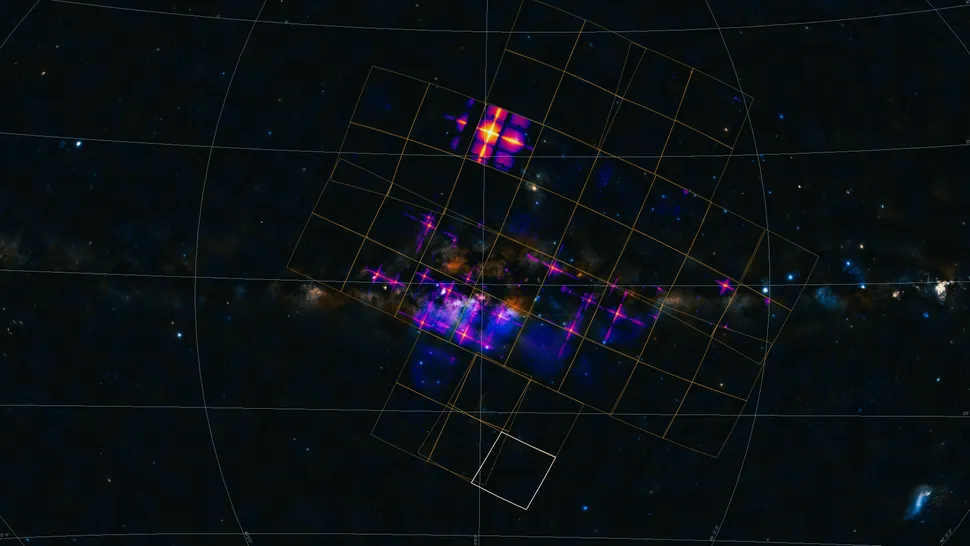A joint Chinese and European X-ray telescope mission called Einstein Probe is successfully viewing the universe in widescreen, with a telescope design that mimics the eyes of lobsters.
Einstein Probe, which launched on Jan. 9 aboard a Chinese Long March rocket, is currently undergoing testing and calibration of its instruments as it orbits the Earth at an altitude of 600 kilometers (373 miles). Its first observations were revealed at a symposium in Beijing.
The problem with X-rays is that they are so high in energy that they are difficult to capture with a standard detector. Lenses don’t work because X-rays are too powerful to be easily refracted, and an X-ray striking a mirror face-on will simply pass through said mirror. Rather, X-ray detection is only possible when these rays strike a reflective surface at a shallow angle. From there, the rays can be directed towards an X-ray-specific detector. However, this mechanism poses a bit of a problem. It means an X-ray telescope can usually only detect X-rays along a narrow field of view; outside of that field of view, X-rays would strike at too great an angle.
As it turns out, lobsters are the solution — lobster vision, that is. What’s more, scientists cottoned onto this basic idea back in the late 1970s, but it has taken decades to successfully adapt that idea for use on X-ray telescopes in space.
Human eyes operate on the principle of refraction via a lens, aka the cornea. Lobsters, on the other hand, utilize reflection. Their eyes are a composite of tiny tubes arranged as parallel square pores on the surface of their eyes, with each tube pointing in a different direction. Light enters the tubes and is reflected down to the retina. Whereas human vision spans a field of about 120 degrees, lobsters have panoramic, 180-degree eyesight.
Lobster-eye X-ray vision has previously been deployed on missions that study the solar wind, on interplanetary missions, and on a technology demonstrator mission called LEIA (Lobster Eye Imager for Astronomy) in 2022. Einstein Probe, however, is the first to employ lobster-eye optics in a space telescope. Its Wide-field X-ray Telescope (WXT) borrows from the design of a lobster’s eye, with hundreds of thousands of tubes arranged in 12 modules that are positioned such that the WXT can take in a field of view encompassing more than 3,600 square degrees, equal to one-eleventh of the sky, in a single shot. In just three orbits, WXT can image the entire sky in X-rays.
WXT is looking for things that go bump in the night: so-called X-ray transients, which are often random or one-off events like a star flaring or a dormant black hole suddenly lighting up with activity when swallowing a small parcel of matter. It also includes phenomena like exploding stars and merging neutron stars that are the source of gravitational waves reverberating throughout the cosmos. This wide field of view should therefore allow WXT to vastly increase our knowledge of these transients.
To complement WXT’s panoramic view, Einstein Probe also carries on board a second telescope, known as the Follow-up X-ray Telescope (FXT), which is a more traditional X-ray detector with a narrower field of view. FXT offers more detailed, close-up observations of any transients discovered by WXT.
Even though it is still in the testing phase, WXT in particular is already proving its purpose. The Beijing symposium revealed that WXT found its first X-ray transient on Feb. 19, an event associated with a long gamma-ray burst produced by the destruction of a massive star. Since then, WXT has discovered another 141 transients including 127 stars unleashing X-ray flares.
FXT has also been busy during this trial period by following-up on an X-ray transient discovered on Marc 20 — by the WXT no less, — as well as imaging several well-known objects in X-rays, including a supernova remnant called Puppis A and the giant globular cluster Omega Centauri.
“I am delighted to see the first observations from Einstein Probe, which showcases the mission’s ability to study wide expanses of the X-ray sky and quickly discover new celestial sources,” said Carole Mundell, who is the European Space Agency’s Director of Science, in a statement. “These early data give us a tantalizing glimpse of the high-energy dynamic universe that will soon be within reach of our science communities.”
“It is astounding that even though the instruments were not yet full calibrated, we could already perform a time-critical follow-up observation using the FXT instrument of a fast X-ray transient first spotted by WXT,” added Erik Kuulkers, who is the European Space Agency’s Project Scientist for Einstein Probe. “It shows what Einstein Probe will be capable of during its survey.”
That survey will initially last three years, and is set to get underway this June once testing is officially complete. The data released at the recent symposium is a preview of just what we can expect.
Einstein Probe is a collaboration between not only the Chinese Academy of Sciences and the European Space Agency, but also the Max Planck Institute for Extraterrestrial Physics (MPE) in Germany and the National Centre for Space Studies (CNES) in France. Its discoveries will provide a huge catalog of objects for Europe’s forthcoming NewAthena (Advanced Telescope for High-Energy Astrophysics) mission, which is currently in the study phase. Planned to be the most powerful X-ray telescope ever built, that instrument is set to launch around 2037.
Source: https://www.space.com/einstein-probe-x-ray-first-light



